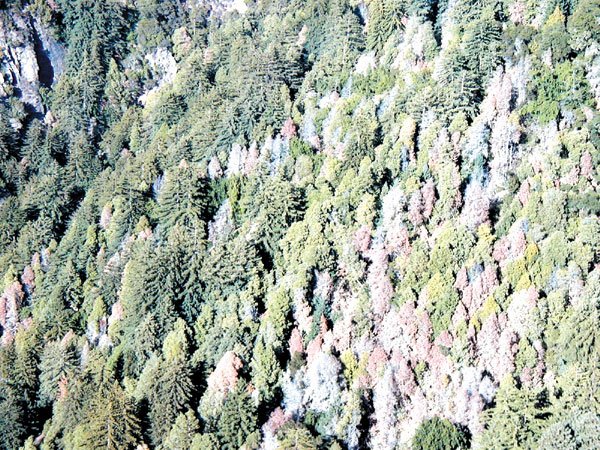Santa Clara and San Benito Counties are under quarantine, but
few residents realize it. They’re still able to come and go as they
please, but the dead trees that flank the very highways they’re
driving on reveal an epidemic.
Santa Clara and San Benito Counties are under quarantine, but few residents realize it. They’re still able to come and go as they please, but the dead trees that flank the very highways they’re driving on reveal an epidemic.
Pine tree pitch canker and sudden oak death syndrome are fungal infections that have taken root in the local tree population. Having appeared mostly in forest plants until recently, they’re a threat to nurseries and a constant reminder of the perils non-native species can bring when they enter an area.
Santa Clara and San Benito Counties are among 14 that are under state and federal quarantines for the fungal growths.
Pitch canker, originally found in the southeastern United States, has had a severe impact on the population of Monterey pines near the coast, where wetter weather fosters the fungus’ growth. It has been found in Mexico, Japan and South Africa as well, according to the University of California Center for Forestry.
Sudden oak death syndrome, whose origin is still unknown, appeared in Europe as early as 1993, but was not recognized as a new species of fungus until 1999, four years after the infection had made its way to California and southern Oregon, according to University of California Integrated Pest Management Program. So far, sudden oak death syndrome has killed hundreds of thousands of trees, decimating more than 118,000 in the Los Padres National Forest alone, said Katie Palmieri, public information officer for the California Oak Mortality Task Force.
No quick fix exists for either of the diseases, both of which are fungus-based killers that create cyst-like lesions called cankers. But the cankers are not the first thing the eye will spot when a tree is infected.
Pine tree pitch canker affects the ends of branches, said Mert Price, deputy agricultural commissioner for Santa Clara County. “Infected trees will have dieback, where the needles will turn brown and fall off at the tips,” he said. “If you cut into it, the wood should have a resin-soaked appearance.”
The symptoms of disease in a tree with sudden oak death syndrome are less obvious at first.
“Oaks become infected through the boles, or trunks,” said Palmieri. “The fungus enters through the bark and creates these cankers that begin to cut off the supplies that are essential to the life of the tree, its water and nutrients. The canker eventually girdles and wraps the trunk, which cuts off all the nutrient supply.”
The tree is then effectively dead, though it will appear relatively healthy until it has used up the last of the nutrients that made the trip past the canker. When these are exhausted, the tree’s leaves suddenly turn brown and drop to the ground, leading to the disease’s descriptive, but not quite accurate name.
There is currently no way to prevent sudden oak death syndrome, which primarily infects Tan and Coast Live oaks, said Larry Costello, a spokesman for the University of California Extension Office in San Mateo.
“If you’re in an area where it’s known to occur, the best thing you can do is just support it as best you can,” said Costello. “That means the right amount of water – not too much and not too little – and minimizing disturbance of the root zone.”
The same thing goes for pine tree pitch canker, which generally infects Monterey pine and Douglas fir trees. However, pitch canker is not always a deadly disease for trees, as some pines recover after extended bouts with the fungal infection and others have natural resistance to the fungus, said Price.
“At one point it was recommended the trees be removed,” said Price. “If a tree tolerates it, there may be some emergence later on.”
Price advised against cutting off infected branches, as evergreens do not have the same ability to generate new branches as deciduous trees. Cutting anywhere behind the needle line of a pine tree will result in the permanent loss of that limb.
Should the tree die, it’s best to compost it on the spot, if possible, said Costello, since the area is already infected with the fungus. While Santa Clara and San Benito Counties are infected with both fungus types, not every portion of the county contains the fungus and authorities hope to slow its spread, said Steve Lyle, a spokesman for the California Department of Food and Agriculture.
“The major avenue of spread is nursery plants,” said Lyle. State and federal regulations oversee the transport of nursery-raised oaks and pines, though personal transportation of infected tree pieces can result in spread as well.
Nurseries are certified yearly by a state inspector, who also conducts monthly visual tests of plants to keep an eye out for either of the fungus infections, which can be harbored in host plants like the California bay laurel. Any plant that is suspected of having the disease is tested, and if the disease is confirmed all plants within 30 feet of the specimen are quarantined for 90 days or destroyed outright.
“The Food and Agriculture code does provide for fines of up to $25,000 if a nursery knowingly, negligently or intentionally caused an infestation, and we could prove it,” said Lyle. “The fine structure is there, but we really are geared toward compliance and working to ensure compliance from the production nurseries.”
For everyday hikers, more simple warnings are in order. Call ahead to the park or county office responsible for overseeing the area in which you plan to hike to see if the fungi that cause pine tree pitch canker or sudden oak death syndrome are present in the area and take a scrub brush, bucket and can of disinfecting spray along for the ride, recommended Palmieri.
When the hike is over, use the scrub brush and bucket to scrub the soles of all boots with water, paying extra attention to ensure no dirt remains trapped in the crevices of the boots.
After that, spray them with the disinfectant. If your car has left the pavement, repeat the process with all tires, Palmieri recommended.
For more information on these tree diseases, visit the University of California’s Integrated Pest Management Web site at www.ipm.UCDavis.edu/PMG/SelectNewPest.Landscape.html and click on the appropriate disease name under “Plant Diseases.” More information on sudden oak death syndrome can also be obtained by visiting www.suddenoakdeath.org.













